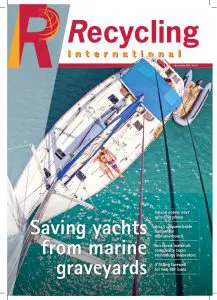Page 35 from: December 2015

33December 2015
Ferrous
At least Chinese billet prices have
recovered from the US$ 250 per tonne
levels noted in our previous report of
late October, exceeding US$ 260 on a
cfr basis.
Export revenue slump
The scale of the scrap price malaise
over the course of this year is clearly
visible in US export statistics for fer-
rous scrap (excluding stainless steel
and alloy scrap). Latest figures from
the Census Bureau and International
Trade Commission confirm that US
overseas shipments amounted to
9.137 million tonnes in the first
three quarters of 2015 – equivalent
to a year-on-year drop of 15.7% from
10.839 million tonnes – whereas total
cargo values slid a heftier 34.6% from
US$ 3.954 billion to US$ 2.584 bil-
lion.
In volume terms, top buyer Turkey upped
its order for American material by 5.4%
to 2.921 million tonnes when compar-
ing the opening nine months of 2015
with the same period last year – but rev-
enues from those transactions slumped
25.6% to just under US$ 735 million.
US shipments to Taiwan fell by 27.3%
to 1.349 million tonnes whereas values
plummeted almost 40% to US$ 389
million; similarly with the South Korean
market, the volumes supplied by Ameri-
ca slumped 36% to 838 247 tonnes but
the drop in revenues was an even more
precipitous 52.6% to US$ 223 million.
Even in the case of India, which
increased its imports from the USA by
a shade under 70% to 603 132 tonnes
in January-September 2015, the over-
all value of these cargoes climbed a far
more conservative 36.5% to US$ 183
million. India swept past China into
fifth place in the league table of US
ferrous scrap importers; in the open-
ing nine months of the year, the latter
cut its order from America by 22.6% to
306 424 tonnes, a total lower than that
for US shipments to Thailand.
Competing commodities
Having threatened to exceed US$ 60
per tonne late in the third quarter, iron
ore prices subsequently slid to levels
which fully reflect the depressed sen-
timent within the global steelmaking
sector. At the time of writing, Metal Bul-
letin’s 62% Fe iron ore index is below
US$ 45 per tonne cfr Qingdao.
In common with the country’s steel
exports, China’s imports of iron ore
failed to match the year-to-date month-
ly average in October. The total of 75.52
million tonnes was around 5% short of
79.39 million tonnes of the same month
last year and more than 12% down on
the September 2015 import tally of 86.1
million tonnes. In the first 10 months of
this year, China bought in some 774.51
million tonnes of iron ore compared to
just over 778 million tonnes in the cor-
responding period of 2014.
Steel
In the year to October, only two of the
world’s top 10 crude steel producers
recorded an increase in output when
compared to the same period in 2014,
according to the latest statistical feed-
back from the World Steel Association
(WSA). India supplanted the USA as
the world’s third largest steelmaker
following a 3.3% hike in its production
to 75.075 million tonnes in January-
October 2015, while Germany’s output
edged 0.3% higher from the same year-
on-year perspective.
Globally, however, crude steel produc-
tion fell 2.5% in the opening 10 months
of this year to 1.346 billion tonnes. For
the fourth month in a row, October
Steel producers question China’s market economy ambitions
As emphasised at the BIR’s late-
October world recycling convention
in Prague, external pressure is mount-
ing on China over its low-priced steel
exports.
Nine leading steel producer bodies
from Europe and the Americas have
issued a joint statement in which
they dismiss claims from China that
it should be automatically accorded
treatment as a market economy
after the fifteenth anniversary of its
accession to the World Trade Orga-
nization (WTO) in December 2016.
The statement is endorsed by: the
American Iron and Steel Institute;
the Steel Manufacturers Associa-
tion; the Canadian Steel Producers
Association; Mexican steel associa-
tion Canacero; Latin American steel
association Alacero; European steel
association Eurofer; Instituto Aco-
Brasil; the Specialty Steel Industry of
North America; and the Committee
on Pipe and Tube Imports.
The Chinese steel industry is ‘the
predominant global contributor’ to
the overcapacity ‘crisis’ afflicting
the world steel industry, they insist.
China’s ‘overwhelmingly state-owned
and state-supported’ steel industry
has an overcapacity of 336 to 425
million tonnes which is expected
to grow in the coming years and is
already resulting in exports that are
on track to exceed 100 million tonnes
this year.
‘Provisions allow WTO members to
treat China as a non-market economy
country unless the government of
China or Chinese producers can show
that they operate under market econ-
omy conditions,’ the statement reads.
‘Given the continuing significant role
of the Chinese government in many
key aspects of the Chinese economy,
and especially in its state-owned and
controlled steel sector, there can be
no question that China remains very
much a non-market economy today.’
At the BIR convention in Prague, Chi-
na’s billet exports at ‘ever-decreasing
prices’ were said to be the main fac-
tor behind the recent slump in ferrous
scrap values.
Eurofer has also issued a call to EU
policy-makers to ‘take immediate
action’ and use ‘the full set of avail-
able trade defence instruments’ to
protect a steel sector that has lost
at least 85 000 jobs since 2008,
including a minimum of 5000 in the
last quarter. ‘Europe needs to rapidly
modernise its trade defence instru-
ments,’ it insists. ‘It can take a year
and a half from complaint to defini-
tive anti-dumping measure. This is
too slow.’



